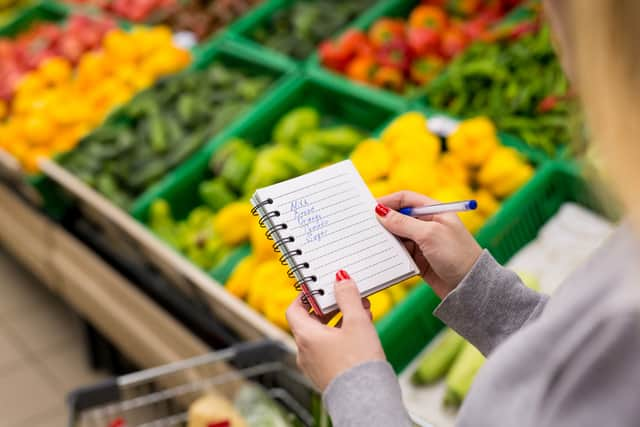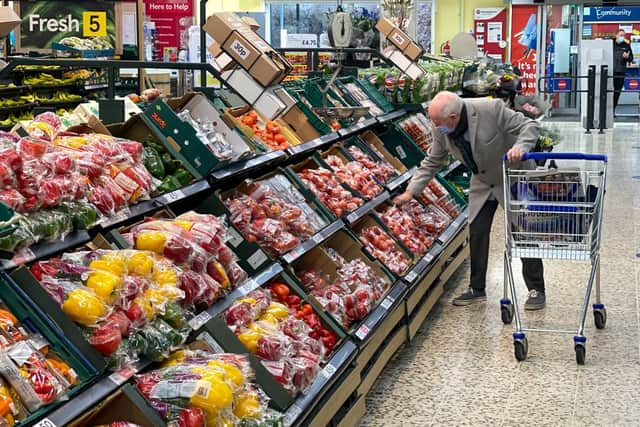How do I save money on food? 7 tips for spending less at the supermarket amid cost of living crisis
This article contains affiliate links. We may earn a small commission on items purchased through this article, but that does not affect our editorial judgement.
and live on Freeview channel 276
The UK is currently in the grip of its worst cost of living crisis in more than a generation.
Household budgets across the country have been squeezed by soaring inflation and rising interest rates, both of which have dented our purchasing power. The price of everything from energy bills and a tank of petrol to mortgage repayments have gone up. At the same time, we’re being taxed at a rate not seen since the Second World War.
Advertisement
Hide AdAdvertisement
Hide AdThe place where price hikes have been most pronounced has been on the food shop. Data from several different analysts has shown double-digit cost increases for consumers. Even supermarket value ranges have not escaped the inflationary trend.
It comes as the Russia-Ukraine conflict has limited the availability of key food ingredients, including cooking oil, as well as vital food production inputs, like fertiliser.
So, if you’re struggling with the cost of living, how can you save on your food shop? NationalWorld has put together some simple solutions to help.
1. Plan ahead and write a shopping list
Planning what food and drink you will need over a specific time period will help you budget shopping more easily.
Advertisement
Hide AdAdvertisement
Hide AdBy turning this meal plan into a shopping list, you then also reduce the chance of making impulse purchases - those little items you don’t need but which often find their way into your trolley thanks in part to subtle marketing tactics.


The BBC Good Food website has dozens of cheap recipe ideas, while authors such as Jack Monroe and Miguel Barclay have cookbooks for people eating on a budget. When drawing up a meal plan, it’s worth remembering that scratch and batch cooked dishes can be cheaper - especially if they can be frozen.
2. Avoid falling into retailer marketing traps
Shops employ subtle marketing practices that try to steer you towards certain products or parts of the store.
End of the aisle shelving is one area where supermarkets often try to tempt shoppers through deals that often look better than they actually are. For example, the price of a medium-sized pack of teabags might have been reduced, but bigger packs on sale in another part of the store could still offer a cheaper price per teabag.
Advertisement
Hide AdAdvertisement
Hide AdYou can only make this sort of comparison if you shop down the aisles, where you can see all the available options and make an informed choice. And even when you’re in an aisle, you should bear in mind that the cheapest deals are not usually at eye level.
It’s worth scanning higher and lower shelves to see if there are better options. For example, you’ll often find supermarket own-brand or value products on lower shelves. They tend to be cheaper than branded items but closely match them for quality.
3. Join loyalty schemes (but shop around)
Loyalty card schemes can save you money, although not all of them offer immediate savings. For example, Tesco Clubcard holders can access special discount prices on popular items both in-store and online.


If you do large, routine shops at the retailer, the Clubcard Plus scheme (where you pay £7.99 for two 10% discounts per month) could be economical - but you should check your numbers to be sure before signing up.
Advertisement
Hide AdAdvertisement
Hide AdSainsbury’s (Nectar), Morrisons (My Morrisons), Waitrose (MyWaitrose), Lidl and the Co-op also offer loyalty schemes which give money off future shops or specific items. However, unless you’ve got a good deal or you only have one big store in your area, it’s usually more cost effective to shop around than rely on loyalty discounts.
So check online before you buy and hedge your bets by signing up to all the schemes. If you are shopping around, factor in these additional considerations:
- How much it will cost you in fuel or fares to get to another store?
- Is the alternative store closer to the town or city centre? Smaller urban stores tend to be more expensive than larger out of town sites
- How much more time will shopping elsewhere take? Time is money and your personal time is the most valuable commodity there is.
4. Shop and eat seasonally
Retailers tend to discount UK fresh produce when it’s in season. For example, during the summer months, strawberries often have one or two crop flushes where a lot of fruit suddenly becomes available.


When this happens, supermarkets usually stock larger packs and push prices down. Currently, the following foods are all in season:
Advertisement
Hide AdAdvertisement
Hide Ad- Spring onions
- Caluiflower
- Kale
- Leeks
- Spinach
- Swede
To find out more about what British produce is in season and when, head to the Eat The Seasons website.
5. Get fruit and veg from the frozen aisle
The frozen aisle tends to be an overlooked part of the supermarket. But, as well as tending to be cheaper, frozen fruit and veg is just as healthy as fresh.
The only downside to frozen veg is that its texture can often be lost in the defrosting process. However, if you’re batch cooking things like curries, chillis or casseroles, you won’t notice.
6. Head to the world food aisle
Another under-appreciated area of the supermarket is the world food aisle. Here you can find common food items in unfamiliar packaging that are often cheaper. For example, you can often make big savings on soy sauce, spices and packets of rice and lentils.
Advertisement
Hide AdAdvertisement
Hide Ad7. Time your supermarket shop
Shopping at unpopular times - especially in the evening - could save you cash. As closing time approaches, supermarkets tend to discount fresh items. These reductions usually get bigger as time goes on.
So, you could grab tonight’s dinner for a fraction of the price if you time it right. To have the best chance of success, scout out your local store at different times to find out when the yellow stickers start to appear.
Comment Guidelines
National World encourages reader discussion on our stories. User feedback, insights and back-and-forth exchanges add a rich layer of context to reporting. Please review our Community Guidelines before commenting.
